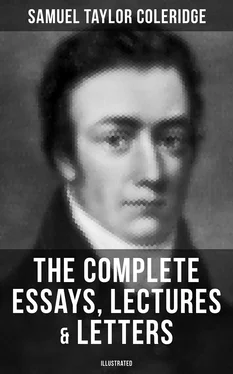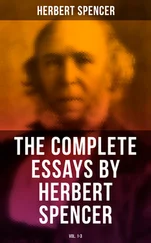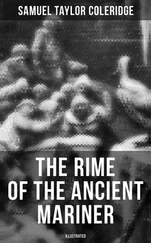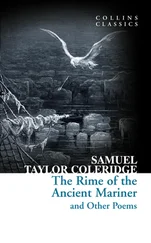The history of philosophy (the same writer observes) contains instances of systems, which for successive generations have remained enigmatic. Such he deems the system of Leibnitz, whom another writer (rashly I think, and invidiously) extols as the only philosopher, who was himself deeply convinced of his own doctrines. As hitherto interpreted, however, they have not produced the effect, which Leibnitz himself, in a most instructive passage, describes as the criterion of a true philosophy; namely, that it would at once explain and collect the fragments of truth scattered through systems apparently the most incongruous. The truth, says he, is diffused more widely than is commonly believed; but it is often painted, yet oftener masked, and is sometimes mutilated and sometimes, alas! in close alliance with mischievous errors. The deeper, however, we penetrate into the ground of things, the more truth we discover in the doctrines of the greater number of the philosophical sects. The want of substantial reality in the objects of the senses, according to the sceptics; the harmonies or numbers, the prototypes and ideas, to which the Pythagoreans and Platonists reduced all things: the ONE and ALL of Parmenides and Plotinus, without Spinozism; the necessary connection of things according to the Stoics, reconcilable with the spontaneity of the other schools; the vital-philosophy of the Cabalists and Hermetists, who assumed the universality of sensation; the substantial forms and entelechies of Aristotle and the schoolmen, together with the mechanical solution of all particular phaenomena according to Democritus and the recent philosophers — all these we shall find united in one perspective central point, which shows regularity and a coincidence of all the parts in the very object, which from every other point of view must appear confused and distorted. The spirit of sectarianism has been hitherto our fault, and the cause of our failures. We have imprisoned our own conceptions by the lines, which we have drawn, in order to exclude the conceptions of others. J’ai trouve que la plupart des Sectes ont raison dans une bonne partie de ce qu’elles avancent, mais non pas tant en ce qu’elles nient.
A system, which aims to deduce the memory with all the other functions of intelligence, must of course place its first position from beyond the memory, and anterior to it, otherwise the principle of solution would be itself a part of the problem to be solved. Such a position therefore must, in the first instance be demanded, and the first question will be, by what right is it demanded? On this account I think it expedient to make some preliminary remarks on the introduction of Postulates in philosophy. The word postulate is borrowed from the science of mathematics . In geometry the primary construction is not demonstrated, but postulated. This first and most simple construction in space is the point in motion, or the line. Whether the point is moved in one and the same direction, or whether its direction is continually changed, remains as yet undetermined. But if the direction of the point have been determined, it is either by a point without it, and then there arises the straight line which incloses no space; or the direction of the point is not determined by a point without it, and then it must flow back again on itself, that is, there arises a cyclical line, which does enclose a space. If the straight line be assumed as the positive, the cyclical is then the negation of the straight. It is a line, which at no point strikes out into the straight, but changes its direction continuously. But if the primary line be conceived as undetermined, and the straight line as determined throughout, then the cyclical is the third compounded of both. It is at once undetermined and determined; undetermined through any point without, and determined through itself. Geometry therefore supplies philosophy with the example of a primary intuition, from which every science that lays claim to evidence must take its commencement. The mathematician does not begin with a demonstrable proposition, but with an intuition, a practical idea.
But here an important distinction presents itself. Philosophy is employed on objects of the inner SENSE, and cannot, like geometry, appropriate to every construction a correspondent outward intuition. Nevertheless, philosophy, if it is to arrive at evidence, must proceed from the most original construction, and the question then is, what is the most original construction or first productive act for the inner sense. The answer to this question depends on the direction which is given to the inner sense. But in philosophy the inner sense cannot have its direction determined by an outward object. To the original construction of the line I can be compelled by a line drawn before me on the slate or on sand. The stroke thus drawn is indeed not the line itself, but only the image or picture of the line. It is not from it, that we first learn to know the line; but, on the contrary, we bring this stroke to the original line generated by the act of the imagination; otherwise we could not define it as without breadth or thickness. Still however this stroke is the sensuous image of the original or ideal line, and an efficient mean to excite every imagination to the intuition of it.
It is demanded then, whether there be found any means in philosophy to determine the direction of the inner sense, as in mathematics it is determinable by its specific image or outward picture. Now the inner sense has its direction determined for the greater part only by an act of freedom. One man’s consciousness extends only to the pleasant or unpleasant sensations caused in him by external impressions; another enlarges his inner sense to a consciousness of forms and quantity; a third in addition to the image is conscious of the conception or notion of the thing; a fourth attains to a notion of his notions — he reflects on his own reflections; and thus we may say without impropriety, that the one possesses more or less inner sense, than the other. This more or less betrays already, that philosophy in its first principles must have a practical or moral, as well as a theoretical or speculative side. This difference in degree does not exist in the mathematics. Socrates in Plato shows, that an ignorant slave may be brought to understand and of himself to solve the most difficult geometrical problem. Socrates drew the figures for the slave in the sand. The disciples of the critical philosophy could likewise (as was indeed actually done by La Forge and some other followers of Des Cartes) represent the origin of our representations in copper-plates; but no one has yet attempted it, and it would be utterly useless. To an Esquimaux or New Zealander our most popular philosophy would be wholly unintelligible. The sense, the inward organ, for it is not yet born in him. So is there many a one among us, yes, and some who think themselves philosophers too, to whom the philosophic organ is entirely wanting. To such a man philosophy is a mere play of words and notions, like a theory of music to the deaf, or like the geometry of light to the blind. The connection of the parts and their logical dependencies may be seen and remembered; but the whole is groundless and hollow, unsustained by living contact, unaccompanied with any realizing intuition which exists by and in the act that affirms its existence, which is known, because it is, and is, because it is known. The words of Plotinus, in the assumed person of Nature, hold true of the philosophic energy. To theoroun mou, theoraema poiei, osper oi geometrai theorountes graphousin; all’ emon mae graphousaes, theorousaes de, uphistantai ai ton somaton grammai. With me the act of contemplation makes the thing contemplated, as the geometricians contemplating describe lines correspondent; but I not describing lines, but simply contemplating, the representative forms of things rise up into existence.
Читать дальше












